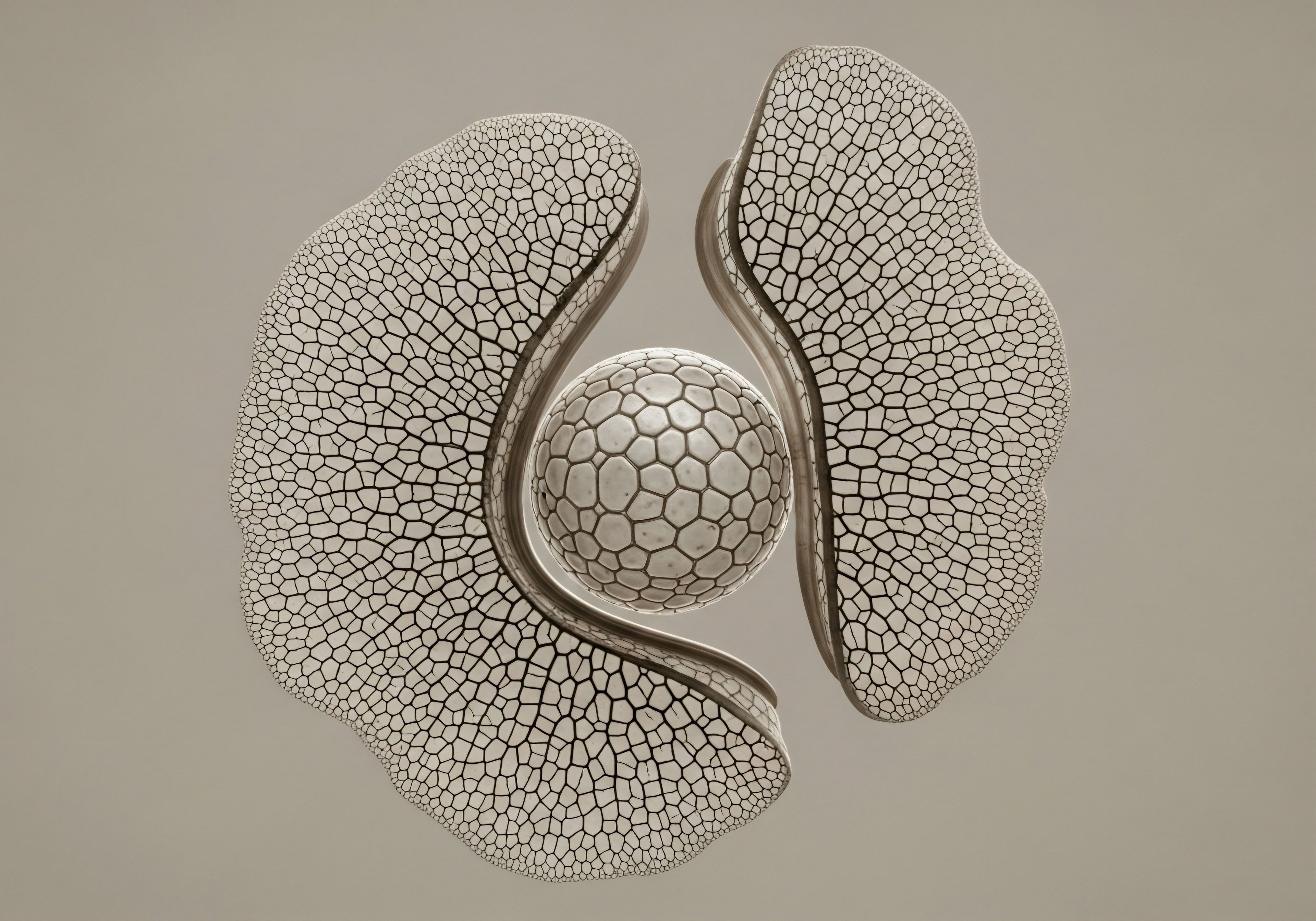

Fundamentals
The feeling often begins subtly. It is a shift in your body’s internal rhythm, a sense that the predictable patterns you have known for decades are beginning to change. Sleep may become less restorative. Your resilience to stress might feel diminished.
The emotional tenor of your days can seem unpredictable, and your body composition may alter despite your consistent efforts with diet and exercise. This experience is the lived reality of perimenopause. It is a profound biological transition, and understanding its origins is the first step toward navigating it with intention and reclaiming your sense of well-being. The question of whether lifestyle alone can manage this transition is a valid and pressing one for anyone seeking to feel their best.
The answer resides deep within your body’s intricate communication network. At the heart of this transition is the Hypothalamic-Pituitary-Gonadal (HPG) axis, a sophisticated feedback loop that governs your reproductive and hormonal health. Think of it as a finely tuned command-and-control system.
The hypothalamus in your brain sends a signal (Gonadotropin-Releasing Hormone, or GnRH) to the pituitary gland. The pituitary, in turn, releases two messenger hormones, Follicle-Stimulating Hormone (FSH) and Luteinizing Hormone (LH), into your bloodstream. These messengers travel to your ovaries, instructing them to mature and release an egg and to produce the primary female sex hormones, estradiol and progesterone.
For decades, this conversation has been consistent and cyclical. Perimenopause marks a change in this dialogue. The ovaries’ response to the pituitary’s signals becomes less robust as the number of available follicles declines. The pituitary gland, sensing a lower response, raises its voice, sending out more FSH in an attempt to get the ovaries’ attention. This creates a state of fluctuating and unpredictable hormonal signals, which is the direct biological driver of the symptoms you experience.

The Power and the Boundaries of Lifestyle
Lifestyle interventions are the essential foundation for navigating perimenopause. They are powerful modulators of your body’s internal environment and can significantly influence how you experience this transition. Strategic nutrition, consistent exercise, restorative sleep, and mindful stress management work in concert to support your overall physiology.
For instance, a diet rich in protein and phytonutrients helps stabilize blood sugar and provides the building blocks for neurotransmitters, which can support mood stability. Resistance training is uniquely effective at preserving lean muscle mass and bone density, two tissues that are vulnerable to the effects of declining estrogen. Practices like yoga and meditation can help regulate the nervous system, mitigating the heightened stress response that many women feel.
Lifestyle choices create a robust physiological foundation, enhancing your body’s ability to adapt to the hormonal shifts of perimenopause.
Research confirms the benefits of these approaches. Studies have shown that yoga can be particularly effective for improving physical and urogenital symptoms. Similarly, aerobic exercise has demonstrated benefits for some women in managing vasomotor symptoms. These interventions work by improving the body’s downstream resilience. They enhance insulin sensitivity, reduce inflammation, support detoxification pathways, and promote balanced brain chemistry. They are the tools you use to optimize the function of every system that is affected by the primary hormonal shift.
Yet, it is vital to understand the boundaries of what lifestyle can achieve. These interventions support the body’s systems. They do not, however, reverse the primary biological event of perimenopause, which is the age-related decline in ovarian function and the resulting alteration in the HPG axis conversation.
Lifestyle choices can help your body better cope with the erratic signals, but they cannot restore the consistent, predictable hormonal signaling of your younger years. When the biological changes become so pronounced that symptoms disrupt your daily life, sleep, and mental health, addressing the root cause of the signaling disruption itself becomes a logical and necessary consideration. This is where the conversation expands to include therapeutic protocols designed to restore biochemical balance.


Intermediate
Moving beyond foundational support requires a shift in perspective. When lifestyle interventions alone are insufficient to restore quality of life, the clinical objective becomes to directly address the biochemical source of the disruption. The goal is to re-establish a more stable and predictable hormonal environment, thereby alleviating the symptoms that arise from the chaotic signaling of the perimenopausal HPG axis.
This is achieved through the precise application of bioidentical hormones, which are molecularly identical to those your body produces. This process is a biochemical recalibration, designed to supplement the hormones your ovaries are no longer consistently supplying.

What Are the Core Clinical Protocols?
The clinical protocols for managing perimenopause are tailored to the individual’s unique physiology and symptoms, as revealed through comprehensive lab work and a detailed personal history. The primary agents used are estradiol, progesterone, and in many cases, testosterone. Each plays a distinct and vital role in female physiology, and their decline contributes to the constellation of perimenopausal symptoms.

Estradiol and Progesterone Therapy
Systemic hormone therapy, using estrogen with a progestin, is recognized as the most effective treatment for vasomotor symptoms like hot flashes and night sweats. Estradiol, the most potent form of estrogen, can be administered through various methods, including transdermal patches, gels, or oral tablets. The method of delivery is a key clinical decision.
Transdermal delivery, for example, bypasses the first-pass metabolism in the liver, which can be advantageous for some individuals. For women who still have a uterus, progesterone is co-administered with estrogen. This is a critical safety measure, as unopposed estrogen can stimulate the growth of the uterine lining (endometrium), increasing health risks.
Progesterone provides a protective effect by balancing estrogen’s influence on the uterus. It also has its own benefits, including a calming effect on the nervous system that can significantly improve sleep quality.

The Role of Testosterone for Women
Testosterone is often perceived as a male hormone, yet it is a critical hormone for women, essential for maintaining energy levels, cognitive function, muscle mass, bone density, and libido. Its production also declines during the perimenopausal transition.
For women experiencing persistent fatigue, brain fog, or a loss of vitality that does not resolve with other interventions, the addition of low-dose testosterone can be transformative. The standard protocol often involves weekly subcutaneous injections of Testosterone Cypionate, typically in the range of 10-20 units (0.1-0.2ml). This approach provides a steady, controlled level of the hormone, avoiding the peaks and troughs that can occur with other methods. For some, long-acting testosterone pellets may be an alternative.
Hormonal optimization protocols are designed to restore the body’s biochemical signaling, directly addressing the root cause of perimenopausal symptoms.
The following table illustrates how these different therapeutic approaches address specific symptoms, building upon a foundation of lifestyle.
| Symptom | Lifestyle Intervention Impact | Hormonal Optimization Impact |
|---|---|---|
| Hot Flashes / Night Sweats |
Can be modestly reduced through stress management and avoiding triggers. Aerobic exercise shows some benefit. |
Highly effective. Systemic estrogen therapy directly stabilizes the thermoregulatory center in the hypothalamus. |
| Sleep Disruption |
Improved with sleep hygiene, yoga, and reduced caffeine/alcohol intake. |
Progesterone has a calming, sedative-like effect that promotes deeper, more restorative sleep. Reduced night sweats also prevent awakenings. |
| Vaginal Dryness / Atrophy |
No significant impact from general lifestyle changes. |
Highly effective. Localized vaginal estrogen restores tissue health, elasticity, and lubrication with minimal systemic absorption. |
| Fatigue / Low Vitality |
Can be improved with nutrient-dense diet, regular exercise, and stress reduction. |
Low-dose testosterone directly addresses the hormonal component of energy production, motivation, and drive. |
| Mood Swings / Irritability |
Can be supported with nutrition that stabilizes blood sugar and practices that regulate the nervous system. |
Stabilizing estrogen and progesterone levels has a direct effect on neurotransmitter systems (serotonin, GABA), promoting a more even mood. |

Supporting the System with Peptide Therapy
In addition to direct hormonal recalibration, certain peptide therapies can be used to support the body’s systems and enhance the effects of hormonal optimization. Peptides are short chains of amino acids that act as precise signaling molecules. They can be used to target specific functions that are often compromised during perimenopause.
- Growth Hormone Peptides ∞ A combination like Ipamorelin and CJC-1295 can be used to stimulate the body’s own natural production of growth hormone. This can lead to improved sleep quality, enhanced tissue repair, better body composition (increased muscle mass and decreased fat), and overall feelings of well-being.
- Peptides for Tissue Repair ∞ Pentadeca Arginate (PDA) is a peptide known for its ability to promote healing and reduce inflammation, which can be beneficial for joint health and recovery from exercise.
- Peptides for Sexual Health ∞ PT-141 works through a unique central nervous system pathway to directly influence sexual arousal and desire, addressing issues that may not fully resolve with testosterone therapy alone.
These protocols, when guided by a knowledgeable clinician, represent a comprehensive approach to managing the biological changes of perimenopause. They build upon a non-negotiable foundation of healthy lifestyle choices to directly address the hormonal shifts at their source, with the goal of restoring function, vitality, and an uncompromised quality of life.


Academic
A comprehensive analysis of perimenopause requires a deep examination of the progressive dysregulation of the Hypothalamic-Pituitary-Gonadal (HPG) axis. This neuroendocrine cascade is not merely a system that turns off; it undergoes a period of chaotic, high-amplitude signaling that has profound systemic consequences.
The core physiological event is ovarian senescence, specifically the depletion of the primordial follicle pool. This depletion precipitates a series of predictable, sequential changes in the HPG feedback loop, which can be understood through its key hormonal mediators.

What Is the Initial Locus of HPG Dysregulation?
The earliest detectable change in the HPG axis during the menopausal transition is a decline in circulating levels of inhibin B. Produced by the granulosa cells of small, growing ovarian follicles, inhibin B exerts a potent negative feedback effect specifically on the pituitary’s secretion of Follicle-Stimulating Hormone (FSH).
As the number of responsive follicles dwindles, inhibin B production falls. This reduction in negative feedback causes pituitary gonadotrophs to secrete more FSH. This isolated rise in early follicular phase FSH is often the first biochemical indicator of reproductive aging, occurring even while menstrual cycles remain regular and estradiol levels are preserved or even elevated.
This compensatory rise in FSH is the system’s attempt to maintain ovarian estrogen production. By increasing the stimulatory signal, the pituitary successfully coaxes the remaining, less responsive follicles to produce estradiol. This phase can be characterized by paradoxically high estradiol levels, interspersed with anovulatory cycles where progesterone is absent.
This erratic hormonal environment of high, fluctuating estrogen and low progesterone contributes significantly to symptoms like breast tenderness, bloating, and heavy or irregular bleeding. It is a state of compensated, yet unstable, ovarian function.

The Transition to Overt Endocrine Failure
As ovarian reserve continues to decline, the compensatory mechanisms begin to fail. The remaining follicles become increasingly resistant to the elevated FSH stimulation. Consequently, estradiol production becomes consistently low. The loss of estradiol’s powerful negative feedback on both the hypothalamus (GnRH secretion) and the pituitary (LH secretion) leads to a dramatic and sustained increase in both FSH and Luteinizing Hormone (LH).
Postmenopause is biochemically defined by this state of persistent hypoestrogenism and elevated gonadotropins. This profound shift in the hormonal milieu has far-reaching implications that extend beyond the reproductive system.
The dysregulation of the HPG axis during perimenopause is a cascade of signaling failures, beginning with inhibin B and culminating in systemic hypoestrogenism and gonadotropin elevation.
The following table outlines the sequential failure of the HPG axis feedback mechanisms.
| Reproductive Stage | Primary Ovarian Change | Key Hormonal Signature | Dominant Clinical Manifestation |
|---|---|---|---|
| Late Reproductive Years |
Initial decline in follicular pool. |
Decreased Inhibin B; Normal Estradiol & LH; Slightly elevated FSH. |
Subtle changes in cycle length; subfertility. |
| Early Perimenopause |
Accelerated follicular depletion. |
Low Inhibin B; High/erratic Estradiol; Markedly elevated and variable FSH. |
Cycle irregularity; vasomotor symptoms begin; sleep disturbances. |
| Late Perimenopause |
Severely diminished follicular reserve. |
Very low Inhibin B; Fluctuating but declining Estradiol; Consistently high FSH (>25 IU/L). |
Prolonged amenorrhea; worsening vasomotor and urogenital symptoms. |
| Postmenopause |
Exhaustion of follicular pool. |
Consistently low Estradiol & Progesterone; Persistently high FSH & LH. |
Cessation of menses; progressive urogenital atrophy; accelerated bone loss. |

Systemic Consequences of HPG Axis Dysregulation
The biological changes of perimenopause are systemic. The loss of stable hormonal signaling impacts numerous non-reproductive tissues that possess receptors for estrogen, progesterone, and androgens.
- Neurological Function ∞ Estradiol is a potent neuromodulator. It influences the synthesis and activity of key neurotransmitters, including serotonin, dopamine, and acetylcholine. The erratic fluctuations and eventual decline of estradiol disrupt this delicate neurochemical balance, contributing to the mood lability, anxiety, and cognitive complaints often described as “brain fog.” Furthermore, some research suggests the dysregulated HPG axis itself, with its high gonadotropin levels, may promote neurodegenerative processes.
- Metabolic Health ∞ Estradiol plays a beneficial role in regulating glucose metabolism and lipid profiles. It promotes insulin sensitivity and favors a healthier distribution of adipose tissue. Its decline is associated with a shift toward central adiposity (visceral fat), increased insulin resistance, and a more atherogenic lipid profile, thereby increasing the long-term risk for metabolic syndrome and cardiovascular disease.
- Musculoskeletal Integrity ∞ The loss of estrogen accelerates bone resorption by osteoclasts, leading to a rapid decrease in bone mineral density. This places women at a significantly higher risk for osteoporosis and fractures. Concurrently, the decline in both estrogen and testosterone contributes to sarcopenia, the age-related loss of muscle mass and strength.
From a systems-biology perspective, lifestyle interventions are powerful tools for mitigating these downstream consequences. An anti-inflammatory diet and exercise can improve insulin sensitivity. Resistance training can directly stimulate muscle protein synthesis and bone formation. However, these interventions cannot restore the primary upstream signaling fidelity of the HPG axis.
They cannot force a depleted ovary to produce estradiol or inhibin B. Therefore, a complete therapeutic strategy considers both addressing the root cause ∞ the loss of hormonal signaling ∞ and optimizing the downstream systems through targeted lifestyle protocols. This dual approach offers the most comprehensive method for managing the profound biological changes of perimenopause.

References
- Money, A. G. et al. “The impact of physical activity and exercise interventions on symptoms for women experiencing menopause ∞ overview of reviews.” Journal of Public Health, 2024.
- Davis, Susan R. and Rodney J. Baber. “Menopausal hormone therapy ∞ the most effective treatment for menopausal symptoms.” The Medical Journal of Australia, vol. 217, no. 10, 2022, pp. 529-535.
- Gordon, J. L. et al. “The role of the hypothalamic-pituitary-adrenal axis in depression across the female reproductive lifecycle ∞ current knowledge and future directions.” Harvard Review of Psychiatry, vol. 26, no. 5, 2018, pp. 274-289.
- Bowen, R. L. and C. Atwood. “Dysregulation of the hypothalamic-pituitary-gonadal axis with menopause and andropause promotes neurodegenerative senescence.” Journal of Neuropathology & Experimental Neurology, vol. 64, no. 2, 2005, pp. 93-97.
- Stuenkel, C. A. et al. “Treatment of Symptoms of the Menopause ∞ An Endocrine Society Clinical Practice Guideline.” The Journal of Clinical Endocrinology & Metabolism, vol. 100, no. 11, 2015, pp. 3975-4011.
- Gleason, C. E. et al. “The Hypothalamic-Pituitary-Gonadal Axis and Women’s Mental Health ∞ PCOS, Premenstrual Dysphoric Disorder, and Perimenopause.” Psychiatric Times, vol. 34, no. 10, 2017.
- American College of Obstetricians and Gynecologists. “ACOG Releases Clinical Guidelines on Management of Menopausal Symptoms.” American Family Physician, vol. 90, no. 5, 2014, pp. 339-346.
- “The 2020 Menopausal Hormone Therapy Guidelines.” Journal of Menopausal Medicine, vol. 26, no. 2, 2020, pp. 69-98.
- Vest, A. R. et al. “The Menopausal Transition and Cardiovascular Disease Risk.” Journal of the American Heart Association, vol. 11, no. 13, 2022, e025849.
- Ko, S. H. and S. H. Kim. “Menopausal Hormone Therapy and Cardiovascular Disease.” Journal of Menopausal Medicine, vol. 27, no. 1, 2021, pp. 1-6.

Reflection
You now possess a deeper map of the biological territory known as perimenopause. You understand the conversation happening within your body, the reasons for its changing tone, and the tools available to help guide it. This knowledge is the foundation. It transforms uncertainty into understanding and empowers you to ask more precise questions.
Your personal health story is unique, written in the language of your own genetics, experiences, and physiology. The path forward involves translating this general scientific knowledge into a specific, personalized strategy. This is a collaborative process, one undertaken with a clinical guide who can help you interpret your body’s signals and co-author the next chapter of your health with clarity and confidence.
What does your body’s changing rhythm feel like to you, and what is the first question you want to ask on your path to reclaiming your vitality?

Glossary

perimenopause

follicle-stimulating hormone

progesterone

lifestyle interventions

nervous system

muscle mass

vasomotor symptoms

hpg axis

clinical protocols

estradiol

hormone therapy

low-dose testosterone

hormonal optimization

ipamorelin

cjc-1295




